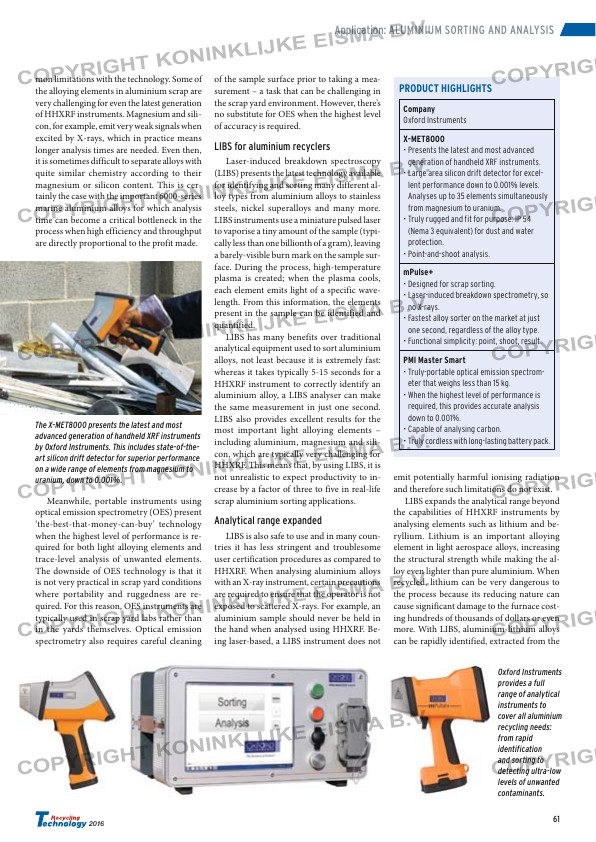Page 59 from: Recycling Technology 2016

61
2016
mon limitations with the technology. Some of
the alloying elements in aluminium scrap are
very challenging for even the latest generation
of HHXRF instruments. Magnesium and sili-
con, for example, emit very weak signals when
excited by X-rays, which in practice means
longer analysis times are needed. Even then,
it is sometimes difficult to separate alloys with
quite similar chemistry according to their
magnesium or silicon content. This is cer-
tainly the case with the important 6000-series
marine aluminium alloys for which analysis
time can become a critical bottleneck in the
process when high efficiency and throughput
are directly proportional to the profit made.
Meanwhile, portable instruments using
optical emission spectrometry (OES) present
‘the-best-that-money-can-buy’ technology
when the highest level of performance is re-
quired for both light alloying elements and
trace-level analysis of unwanted elements.
The downside of OES technology is that it
is not very practical in scrap yard conditions
where portability and ruggedness are re-
quired. For this reason, OES instruments are
typically used in scrap yard labs rather than
in the yards themselves. Optical emission
spectrometry also requires careful cleaning
of the sample surface prior to taking a mea-
surement – a task that can be challenging in
the scrap yard environment. However, there’s
no substitute for OES when the highest level
of accuracy is required.
LIBS for aluminium recyclers
Laser-induced breakdown spectroscopy
(LIBS) presents the latest technology available
for identifying and sorting many different al-
loy types from aluminium alloys to stainless
steels, nickel superalloys and many more.
LIBS instruments use a miniature pulsed laser
to vaporise a tiny amount of the sample (typi-
cally less than one billionth of a gram), leaving
a barely-visible burn mark on the sample sur-
face. During the process, high-temperature
plasma is created; when the plasma cools,
each element emits light of a specific wave-
length. From this information, the elements
present in the sample can be identified and
quantified.
LIBS has many benefits over traditional
analytical equipment used to sort aluminium
alloys, not least because it is extremely fast:
whereas it takes typically 5-15 seconds for a
HHXRF instrument to correctly identify an
aluminium alloy, a LIBS analyser can make
the same measurement in just one second.
LIBS also provides excellent results for the
most important light alloying elements –
including aluminium, magnesium and sili-
con, which are typically very challenging for
HHXRF. This means that, by using LIBS, it is
not unrealistic to expect productivity to in-
crease by a factor of three to five in real-life
scrap aluminium sorting applications.
Analytical range expanded
LIBS is also safe to use and in many coun-
tries it has less stringent and troublesome
user certification procedures as compared to
HHXRF. When analysing aluminium alloys
with an X-ray instrument, certain precautions
are required to ensure that the operator is not
exposed to scattered X-rays. For example, an
aluminium sample should never be held in
the hand when analysed using HHXRF. Be-
ing laser-based, a LIBS instrument does not
emit potentially harmful ionising radiation
and therefore such limitations do not exist.
LIBS expands the analytical range beyond
the capabilities of HHXRF instruments by
analysing elements such as lithium and be-
ryllium. Lithium is an important alloying
element in light aerospace alloys, increasing
the structural strength while making the al-
loy even lighter than pure aluminium. When
recycled, lithium can be very dangerous to
the process because its reducing nature can
cause significant damage to the furnace cost-
ing hundreds of thousands of dollars or even
more. With LIBS, aluminium-lithium alloys
can be rapidly identified, extracted from the
Application: ALUMINIUM SORTING AND ANALYSIS
PRODUCT HIGHLIGHTS
Company
Oxford Instruments
X-MET8000
generation of handheld XRF instruments.
–
lent performance down to 0.001% levels.
Analyses up to 35 elements simultaneously
from magnesium to uranium.
(Nema 3 equivalent) for dust and water
protection.
mPulse+
no X-rays.
one second, regardless of the alloy type.
PMI Master Smart
–
eter that weighs less than 15 kg.
required, this provides accurate analysis
down to 0.001%.
Oxford Instruments
provides a full
range of analytical
instruments to
cover all aluminium
recycling needs:
from rapid
identification
and sorting to
detecting ultra-low
levels of unwanted
contaminants.
The X-MET8000 presents the latest and most
advanced generation of handheld XRF instruments
by Oxford Instruments. This includes state-of-the-
art silicon drift detector for superior performance
on a wide range of elements from magnesium to
uranium, down to 0.001%.



